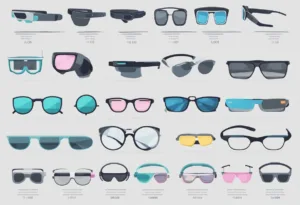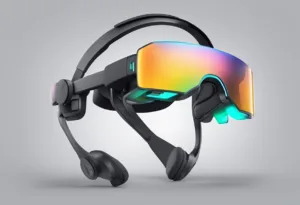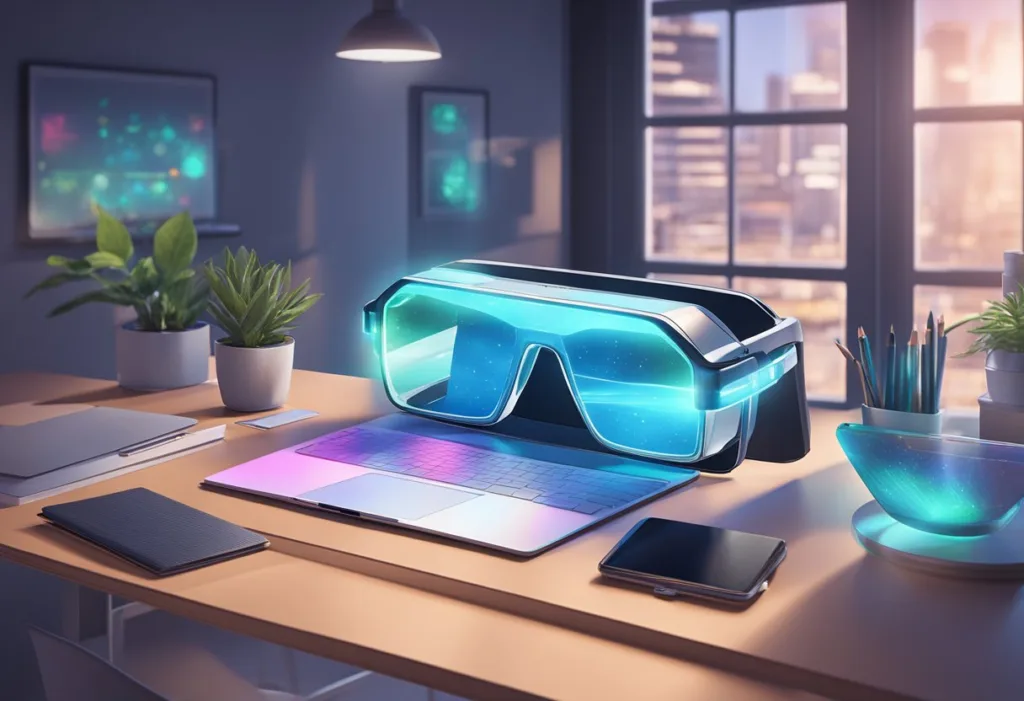AR glasses, also known as augmented reality glasses, are an innovative wearable technology that allows users to experience digital content overlaid on the real world. These glasses have been around for a few years, but they are still considered a new and exciting technology that has yet to reach its full potential. AR glasses can be used for a variety of purposes, including gaming, entertainment, productivity, and professional use cases.
The history and evolution of AR glasses dates back to the 1960s, when the first head-mounted display was created. Since then, the technology has advanced significantly, and AR glasses have become more lightweight, comfortable, and affordable. Today, there are many major brands and products that offer AR glasses, each with its own unique features and capabilities.
Key Takeaways
- AR glasses are an innovative wearable technology that allows users to experience digital content overlaid on the real world.
- AR glasses have a variety of use cases, including gaming, entertainment, productivity, and professional use cases.
- The history and evolution of AR glasses dates back to the 1960s, and today there are many major brands and products that offer AR glasses.
History and Evolution of AR Glasses
AR glasses have come a long way since the first wearable screens appeared in the 1960s. Although the earliest recorded mention of eyeglasses is attributed to Roger Bacon in 1268, it was not until the 1960s that the first head-mounted display system was developed by Ivan Sutherland, which laid the foundation for virtual reality (VR) and augmented reality (AR) technologies.
The difference between VR and AR is that VR immerses the user in a completely digital environment, while AR overlays digital information onto the real world. AR glasses are a form of wearable technology that use sensors and cameras to detect the user’s surroundings and project digital information onto a transparent screen in front of the user’s eyes.
Key Players in AR Development
Smart glasses, often dubbed as “wearable computers”, bridge the gap between the physical and the digital world. Over the past decade, AR glasses have evolved from being wildly expensive, clunky and experimental to being discreet and highly functional. While it is still a stretch to call any brand of AR glasses cheap, the cost has come down dramatically.
Some of the key players in the development of AR glasses include Google, Microsoft, and Apple. Google was one of the first companies to enter the market with its Google Glass, which was released in 2013. However, the device was criticized for its high price and privacy concerns. Microsoft followed suit with its HoloLens, which was released in 2016 and targeted towards enterprise users. Apple is also rumored to be working on its own AR glasses, although the release date is still unknown.
The history and evolution of AR glasses has been marked by a steady progression towards more advanced and sophisticated technology. As AR continues to gain popularity and become more mainstream, it is likely that we will see even more innovation and development in this field.
AR Glasses Technology

Augmented Reality (AR) glasses are wearable devices that overlay digital information, graphics, and virtual objects onto the real world. They are a form of head-mounted display (HMD) that allows users to experience and interact with virtual content without the need for a separate screen or device. AR glasses come in different shapes, sizes, and designs, but they all have one thing in common: the enhancement of reality with digital overlays.
Display Technologies
AR glasses use different display technologies to project digital information onto the real world. OLED displays and micro-OLED displays are commonly used in AR glasses because of their high resolution, brightness, and contrast ratio. OLED displays provide excellent color accuracy and contrast, while micro-OLED displays offer high pixel density and low power consumption.
Spatial Computing and AI Integration
AR glasses use spatial computing and AI integration to provide a seamless experience for users. Spatial computing allows AR glasses to understand the real world environment and track the user’s movements and gestures. AI integration enables AR glasses to recognize objects, people, and text in the real world and provide relevant information and interactions.
AR glasses also have a field of view (FOV) that determines the size of the virtual content that can be displayed. A wider FOV allows for a more immersive experience, while a narrower FOV limits the amount of virtual content that can be displayed. AR glasses with a wider FOV are generally more expensive and require more processing power.
AR glasses are an exciting technology that has the potential to revolutionize the way we interact with the world around us. With the use of OLED displays, micro-OLED displays, spatial computing, and AI integration, AR glasses can provide a seamless and immersive experience for users. As the technology continues to evolve, we can expect to see even more advanced features and capabilities in future AR glasses.
AR Glasses Design and Wearability

Ergonomics and Comfort
When it comes to AR glasses, ergonomics and comfort are essential factors to consider. Designers of AR glasses are striving to make them as comfortable as possible, given that users will be wearing them for extended periods. The AR glasses must be lightweight and not cause any discomfort to the user. AR glasses should also fit securely, without being too tight or too loose.
The Vision Pro AR glasses are an excellent example of ergonomics and comfort. They are designed to be lightweight, and their temple tips are adjustable, making them comfortable for extended use. The glasses have a nose bridge that can be adjusted to fit the user’s nose comfortably.
Prescription Integration
Prescription integration is another essential factor to consider when designing AR glasses. It is essential to ensure that users who require prescription glasses can use AR glasses without any discomfort.
The Prescription Lens Frame from North is an excellent example of prescription integration. The frame is designed to fit prescription lenses, allowing users to see clearly without any discomfort. This frame is also compatible with North’s Focals smart glasses, making them an excellent choice for anyone who requires prescription glasses.
Wearables are becoming increasingly popular, and AR glasses are no exception. By integrating wearables into AR glasses, designers can create a more comfortable and convenient user experience. It is essential to consider ergonomics, comfort, and prescription integration when designing AR glasses. The Vision Pro AR glasses and Prescription Lens Frame from North are excellent examples of how designers can create AR glasses that are both comfortable and practical for users.
Key Features of AR Glasses

AR glasses are a type of wearable technology that overlays digital information onto the user’s real-world view. They offer a range of features that enhance the user’s experience, including immersive visuals, interactivity, and physical control.
Immersive Experience
AR glasses provide an immersive experience by projecting digital information onto the user’s real-world view. This creates a seamless blend between the digital and physical worlds, allowing the user to interact with digital objects as if they were real.
One of the key features of AR glasses is head tracking, which allows the glasses to track the user’s head movements and adjust the digital information accordingly. This creates a more realistic and immersive experience, as the digital objects move and react in real-time to the user’s movements.
Interactivity and Control
AR glasses offer a range of interactivity and control options, allowing users to interact with digital objects using physical gestures and voice commands. This hands-free interaction creates a more natural and intuitive experience, allowing users to focus on the task at hand without being distracted by a separate input device.
Physical control options, such as buttons and touchpads, provide users with additional control over the digital objects. This allows for more precise interactions, such as selecting specific items or adjusting the size and position of digital objects.
AR glasses offer a range of features that enhance the user’s experience, including immersive visuals, interactivity, and physical control. These features create a seamless blend between the digital and physical worlds, allowing users to interact with digital objects as if they were real.
Major Brands and Products

Apple’s Foray into AR
Apple has been a major player in the AR space for several years now. The company’s ARKit platform has allowed developers to create AR experiences for iOS devices, and the company has also released its own AR glasses, the Apple Vision Pro. These glasses are designed for enterprise use and are equipped with a range of features, such as head tracking, voice control, and gesture recognition.
Microsoft and Lenovo’s Contributions
Microsoft and Lenovo have also made significant contributions to the AR space. Microsoft’s HoloLens 2 is one of the most advanced AR glasses on the market, offering a wide field of view, hand tracking, and voice control. The device is aimed primarily at enterprise customers, and is used in a range of industries, from healthcare to manufacturing.
Lenovo has also released its own AR glasses, the ThinkReality A3. These glasses are wired and are designed for use with PCs and Motorola smartphones. The glasses offer a range of features, such as voice control, gesture recognition, and a 1080p display. They are aimed primarily at enterprise customers, and are used in a range of industries, from logistics to retail.
Apple, Microsoft, and Lenovo are some of the major players in the AR space, with each company offering its own unique set of products and features. While Apple’s AR glasses are designed for enterprise use, Microsoft’s HoloLens 2 is aimed at a wider range of industries, and Lenovo’s ThinkReality A3 is designed for use with PCs and Motorola smartphones.
AR Glasses in Gaming and Entertainment
With the advent of AR glasses, the gaming and entertainment industry has seen a significant shift in the way users interact with their favorite content. AR glasses offer a unique and immersive experience that is not possible with traditional screens. In this section, we will explore the various applications of AR glasses in gaming and entertainment.
Gaming Applications
AR glasses have revolutionized the gaming industry, providing a more immersive gaming experience. Rokid Max and Nreal Air are two of the most popular AR glasses in the gaming industry. Rokid Max offers a 120-degree field of view, while Nreal Air provides a 52-degree field of view. Both glasses are designed to provide users with the most immersive gaming experience, allowing them to interact with their virtual environment in real-time.
AR glasses are also being used to enhance traditional board games. For instance, Monopoly Live, a game that combines the classic board game with augmented reality, has become a popular choice among gamers. It allows players to interact with the virtual environment and see their progress in real-time.
Media Consumption
AR glasses are also being used to enhance media consumption. They provide a unique experience that is not possible with traditional screens. TCL NXTWEAR S glasses are a popular choice among users for media consumption. They provide a 201-inch wide screen in front of the user’s eyes, with support for 1920 x 1080 resolution for 2D and 3840 x 1080 for 3D content. They connect to devices via the USB-C port, making them easy to use with smartphones, laptops, and gaming consoles.
AR glasses have revolutionized the gaming and entertainment industry, providing users with a more immersive experience. They are being used to enhance traditional board games and media consumption. Rokid Max, Nreal Air, and TCL NXTWEAR S glasses are some of the most popular AR glasses in the gaming and entertainment industry.
Productivity and Professional Use Cases
Augmented Reality (AR) glasses are not only for entertainment purposes but also have a
wide range of professional use cases. AR glasses can enhance productivity and efficiency in various industries. In this section, we will explore some of the enterprise solutions and educational applications of AR glasses.
Enterprise Solutions
AR glasses can revolutionize the way people work in various industries. They can help workers perform tasks more efficiently, leading to increased productivity. AR glasses enable remote collaboration, allowing experts to provide guidance and support from anywhere in the world. This fosters teamwork, knowledge sharing, and problem-solving.
AR glasses can also be used in manufacturing, where they can display real-time data and instructions to workers. This can help workers perform tasks with greater accuracy and speed. In the medical field, AR glasses can assist surgeons during operations by displaying vital information and allowing them to keep their hands free.
Educational Applications
AR glasses can also be used in the classroom to enhance the learning experience. They can provide students with a more interactive and engaging way to learn. AR glasses can display 3D models of complex concepts, making them easier to understand. They can also provide students with a virtual tour of historical sites or scientific phenomena.
AR glasses can also be used in vocational training, where they can simulate real-world scenarios. This can help students learn practical skills in a safe and controlled environment. AR glasses can also be used in language learning, where they can display translations and provide real-time feedback on pronunciation.
AR glasses have the potential to revolutionize the way people work and learn. They can enhance productivity, improve accuracy, and provide a more engaging learning experience. As the technology continues to evolve, we can expect to see even more innovative use cases for AR glasses in the future.
Connectivity and Compatibility

Smartphone and Computer Integration
When choosing AR glasses, compatibility with smartphones and computers is an important factor to consider. Most AR glasses require a USB-C port to connect to a device, so it’s important to ensure that the device has a USB-C port or an adapter is available.
Some AR glasses offer wireless connectivity options such as casting, which allows users to mirror their smartphone or computer screen onto the AR glasses. This is a convenient feature for those who want to use AR glasses for productivity or entertainment purposes.
Peripheral Devices
AR glasses can be integrated with peripheral devices such as headphones, microphones, and controllers. This can enhance the user experience and provide more functionality.
It’s important to ensure that the AR glasses are compatible with the peripheral devices that the user wants to use. Some AR glasses come with built-in speakers or microphones, while others require external devices to be connected. It’s important to consider connectivity and compatibility when choosing AR glasses. Users should ensure that the AR glasses are compatible with their devices and peripheral devices to get the most out of their AR experience.
Audiovisual Capabilities
Visual Clarity and Resolution
AR glasses have come a long way since their inception, and one of the most significant improvements has been in the visual clarity and resolution. Many AR glasses today have HD displays that provide a clear and crisp image. The resolution is typically 1080p, which is more than enough for most use cases. This level of clarity is essential for AR glasses to be useful in professional settings such as architecture, engineering, and medicine.
Many AR glasses have adjustable lenses that allow the user to focus on the image and adjust the distance between the lenses to match their eyes. This feature helps to reduce eye strain, which can be a significant issue when using AR glasses for extended periods.
Audio Technology
Audio is another critical aspect of AR glasses. Many AR glasses have built-in speakers that provide high-quality sound. The speakers are typically positioned near the ears, which creates an immersive audio experience. However, some AR glasses also have the option to use headphones for a more private audio experience.
Microphones are also an essential feature of AR glasses. They allow the user to communicate with the AR glasses and control them using voice commands. The microphones can also be used to record audio, which is useful in professional settings such as journalism and filmmaking.
The audiovisual capabilities of AR glasses have improved significantly in recent years, making them an excellent tool for professionals and consumers alike. With high-quality displays and audio technology, AR glasses can provide an immersive and interactive experience that is unlike anything else.
Market Trends and Consumer Adoption

Popular AR Glasses Models
AR glasses have become increasingly popular in recent years, with several models available in the market. Some of the most popular AR glasses models include Snap’s Spectacles, Nreal Air, Xreal Air 2 Pro, Amazon’s Echo Frames, and Samsung’s Gear VR. Each of these models has its unique features and specifications, making them suitable for different use cases.
Snap’s Spectacles are designed for social media enthusiasts, allowing them to capture and share their experiences in real-time. Nreal Air is a lightweight and stylish AR glasses model that offers a wide field of view, making it suitable for gaming and entertainment.
Xreal Air 2 Pro is another popular AR glasses model that offers advanced features such as hand tracking and gesture recognition, making it ideal for industrial use cases. Amazon’s Echo Frames are designed for everyday use, allowing users to access Alexa hands-free. Samsung’s Gear VR is a virtual reality headset that offers a fully immersive experience, making it suitable for gaming and entertainment.
Factors Influencing Market Growth
Several factors are influencing the growth of the AR glasses market, including technological advancements, consumer demand, and the COVID-19 pandemic. Technological advancements in AR glasses have led to the development of more advanced and sophisticated models, making them suitable for a wide range of use cases. Consumer demand for AR glasses has also increased in recent years, driven by the growing popularity of AR applications and use cases.
The COVID-19 pandemic has also had a significant impact on the AR glasses market, with many businesses and organizations adopting AR glasses to enable remote work and collaboration. The pandemic has also led to an increase in demand for AR glasses in the healthcare sector, with healthcare professionals using AR glasses to provide remote consultations and surgeries.
The AR glasses market is expected to continue growing in the coming years, driven by technological advancements, consumer demand, and the increasing adoption of AR glasses in various industries.
Future of AR Glasses
Advancements in Technology
AR glasses are continuously evolving, and with advancements in technology, they are becoming more advanced and sophisticated. Qualcomm, for instance, has been working on a new processor that will help improve the performance of AR glasses. The processor will be designed to handle the complex computations required for AR, and it is expected to improve the overall performance of AR glasses.
Another area of advancement is in micro-OLED technology. Micro-OLED displays are much smaller and more power-efficient than traditional OLED displays, making them ideal for AR glasses. With micro-OLED displays, AR glasses can be made smaller, lighter, and more comfortable to wear for extended periods.
Refresh rate is another area of focus for AR glasses. A high refresh rate is essential for AR glasses to provide a smooth and seamless experience. The higher the refresh rate, the more responsive and immersive the experience will be. Spatial computing is also a crucial area of development for AR glasses. Spatial computing refers to the ability of AR glasses to understand and interact with the world around them. With spatial computing, AR glasses can provide more accurate and realistic experiences.
Potential New Use Cases
AR glasses have the potential to revolutionize many industries. In the medical field, AR glasses can be used to provide doctors with real-time information during surgeries. In the construction industry, AR glasses can be used to provide workers with real-time information about the project they are working on. In the education field, AR glasses can be used to provide students with immersive and interactive learning experiences.
AR glasses can also be used for entertainment purposes. With AR glasses, users can experience movies and games in a whole new way. They can also be used for virtual tourism, allowing users to explore different parts of the world without leaving their homes.
In conclusion, the future of AR glasses is bright, with advancements in technology and potential new use cases. As AR glasses become more advanced and sophisticated, they have the potential to revolutionize many industries and provide users with immersive and interactive experiences.
Frequently Asked Questions

How do augmented reality glasses work?
Augmented reality glasses work by overlaying digital information onto the real world. The glasses use sensors and cameras to track the user’s movements and surroundings, and then display relevant information in the user’s field of view. This information can include anything from directions to a nearby restaurant to virtual objects that appear to be part of the real world.
What are the current price ranges for AR glasses?
The price ranges for AR glasses can vary greatly depending on the brand and features. Some basic models can be purchased for a few hundred dollars, while more advanced models can cost several thousand dollars. As the technology advances and becomes more widespread, it is expected that the price of AR glasses will continue to decrease.
Which AR glasses are considered the best on the market?
There are several AR glasses on the market that are considered some of the best available. Some of the top models include Microsoft HoloLens 2, Magic Leap One, and Vuzix Blade. Each of these glasses has its own unique features and advantages, and the best choice will depend on the user’s specific needs and preferences.
Are there AR glasses specifically designed for gaming?
Yes, there are AR glasses specifically designed for gaming. These glasses typically include features such as motion tracking, gesture recognition, and high-quality displays to provide an immersive gaming experience. Some of the top gaming AR glasses on the market include the Razer Anzu and the Nreal Light.
What are some common disadvantages or limitations of AR glasses?
One common disadvantage of AR glasses is that they can be heavy and uncomfortable to wear for extended periods of time. Another limitation is that they may not work well in bright sunlight or other challenging lighting conditions. Some users may experience motion sickness or other discomfort when using AR glasses.
Which tech companies are leading in AR glasses development?
Several tech companies are currently leading in AR glasses development, including Microsoft, Google, Apple, and Facebook. Each of these companies has invested heavily in AR technology and is working to create new and innovative AR glasses that will change the way we interact with the world around us.














